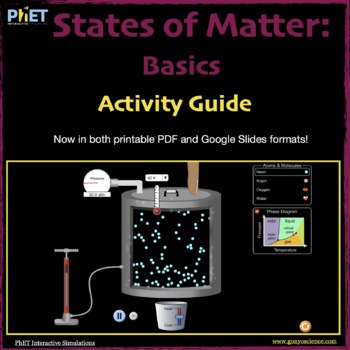PhET States of Matter Basics Activity Guide / Distance Learning
- Zip
- Google Apps™
- Easel Activity

What educators are saying
Also included in
- Now includes printable PDF, Google Slides, and TPT Easel versions!The PhET Chemistry Activity Guides are used along with the free *Next Generation PhET Simulations. All activity guides are in PDF and Google Slides formats and include an answer key and a Getting Started Guide for teachers.Your studenPrice $28.00Original Price $35.00Save $7.00
Description
PhET States of Matter: Basics ACTIVITY GUIDE
Now includes both printable PDF and Google Slides versions!
The PhET: States of Matter Basics Activity Guide is used along with the free *Next Generation PhET Simulation on States of Matter. Students will examine the motion of atoms and molecules of various substances in their solid, liquid, and gas state.
Your students will hit the ground running without the need for a lengthy introduction from you. Just print the activity guide or share from your Google Drive. Students can watch the intro videos and away they go. The best part is that they don’t even know they are learning, they just think they are having fun!
The activity guide takes students through the 2 parts of the simulation: States, and Phase Changes. The lesson includes two followup sections, Understanding Phase Change and Understanding Triple Point and Critical Point to challenge students to expand on what they have learned. Students will learn:
- how atoms and molecules behave in solids, liquids, and gases
- the relationship between temperature and pressure in a closed system
- the concept of absolute zero and how extreme cold affects atoms and molecules
- to identify the melting and boiling points of a substance based on the movement of atoms
- to write a law to explain how changes in temperature affect changes in pressure
- to understand how adding or removing energy (heat) can result in a change of phase
- to understand the concepts of Triple Point and Critical Point of a substance
The activity guide begins with a short introductory video to give students background information and includes both PDF and Google Slides versions for printing worksheets or sharing via Google Drive or Google Classroom. This lesson is perfect for face to face, hybrid, or remote learning!
This product includes the Activity Guide (pdf), Activity Guide (Google Slides), Answer Key (pdf), and a Getting Started Guide for teachers.
*PhET simulations are fun, interactive, research-based simulations of physical phenomena. As students interact with the simulation, they get immediate feedback about the affects of the changes they made. All PhET simulations are freely available from the PhET website (phet.colorado.edu) and are easy to use and incorporate into the classroom. The new Next Generation sims utilize HTML 5 which allows them to run in any modern web browser on most devices including Chromebooks and tablets like the iPad! Learn more about using PhET Simulations with your students.
Bundle and save!







